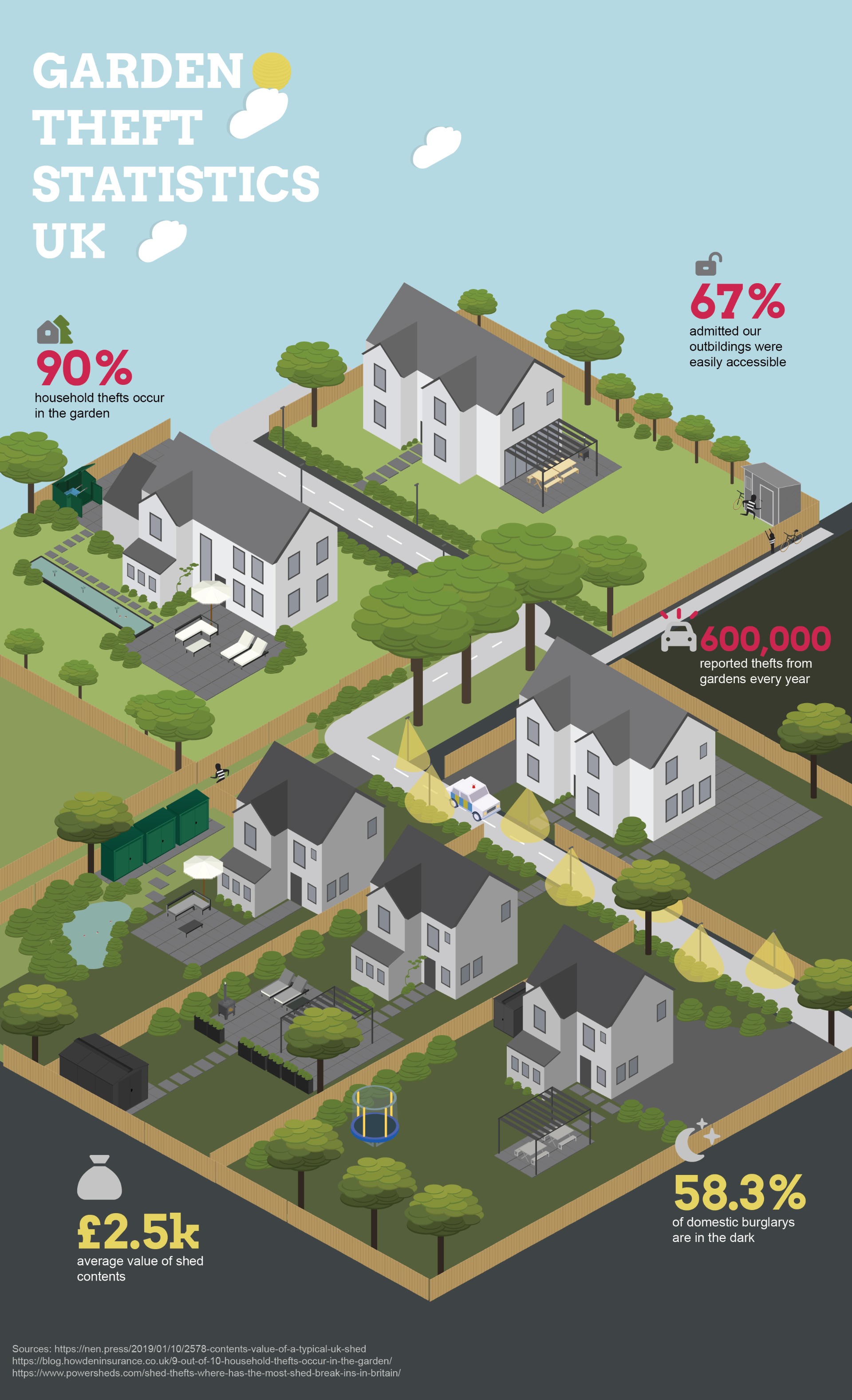How big a problem is theft from gardens?
Garden crime is a large, and growing, problem. A National Garden Crime Survey commissioned by Gardening.
Which? found that 1.6 million house holds had suffered theft from their gardens in the previous two years, and a further 0.6 million fell victim to garden vandalism. Around £90 million worth of items was stolen.

What sort of things are stolen?
Bicycles are top of the list, followed by plants then power machinery, including lawnmowers. Hand tools are frequently taken and, together with ladders, may then be used to gain access to the house. Containers, ornaments, and furniture are also popular targets.
More unusual burgled items include three cement mixers, a pair of gardening gloves and a one-eyed gnome stolen from the same garden, a 6m high pair of wrought iron gates, a pair of ducks, an entire front lawn, a whole conservatory, a 12m length of newly planted hedge and valuable koi carp, thieves stole the fish first, then came back a few days later and stole the pond.
Victorian edging tiles worth £10 each were taken in a series of 17 burglaries concentrated in three streets in Lincoln.
Where are they stolen from?
Many thefts occur in the open garden, but sheds and garages are increasingly being targeted, particularly during the summer.
The contents of my shed aren't worth much and I only spend a few pounds a year on plants;
Should I be worried?
Perhaps not, but you have to think about what your garden would cost to replace, not to create. Your hand tools, perhaps inherited or bought second-hand, could easily cost £200 to replace, and the shrubs you raised from cuttings could now be worth £50 each as mature specimens.
What can I do to protect my garden?
There are two basic approaches: making the most likely targets of theft more secure and making the garden as a whole less attractive to thieves.
How do I make my garden less attractive to thieves?
Start with secure boundaries. At the back, prickly hedges such as hawthorn, pyracantha or berberis are a good deterrent, and adding a foot or two of trellis to a fence panel makes it much more difficult to climb, without making the garden feel too shut in. At the front of the house, don't give thieves anywhere to hide; make sure the garden is visible from the road.
The police recommend that front hedges are kept at a height of 0.9m or less. Loose gravel, which is noisy when walked on, will put off intruders,as will security lights and alarms. If you have a house alarm, you could include your garage or shed in the system, or you can get battery-operated alarms either for a building or fit to a garden ornament. These are sometimes available at a discount from police stations.
What is the best way to secure tools and equipment?
A Lock them up in a secure shed or garage, or take them into the house. Secure the doors of sheds or garages by fitting two high-security padlocks, one a third of the way up from the bottom of the door, the other a third of the way down from the top. Ordinary screws are easy to undo or prise off, so secure the padlock hasps with coach bolts or clutch-head screws (available from hardware stores). Individual tools and ladders can be secured with a chain attached to the wall. Make sure the roof is securely fixed, fit grilles to the windows, and use curtains or blinds to hide the shed contents from view.
Should I mark belongings in my garden?
Putting your postcode on your belongings makes it three times more likely you will get them back if they are stolen. You can do this by painting, engraving or burning it into an inconspicuous place, or using a special pen only readable by ultraviolet light, often available free from the police. You can even get microchips to insert into statues and other valuable items. Customising tools, for example by painting stripes on your spade or flowers on your mower, is a deterrent as it makes them too recognisable to sell.
Where can I go for advice about my particular garden?
All police forces offer crime prevention information in the form of leaflets, and additional advice that can be tailored to your particular circumstances. Local Neighbourhood Watch and similar schemes of which there are now over 100,000 around the country can also help to protect property.
At least I'm insured!
Not necessarily. Tools and equipment in a reasonably secure garden shed should be covered by your house contents insurance, and the shed itself by the house buildings insurance. However, if your hedge trimmer is stolen from the garden while you go in for lunch, it may well not be covered and, even if it is, there may be a limit as low as £100. If you keep it at your allotment, then it is unlikely to be covered at all. Cover for garden plants is becoming more common but you still have to watch out for limits that are often as low as a few hundred pounds inadequate to replace even a modest container plant collection or a vandalised shrub border. General policies rarely cover livestock, so if you have valuable fish or birds, get them covered separately.
So how do I make sure I am covered?
First, work out what it would cost to replace all your garden tools and equipment and even any plants you want to insure. Remember, mature plants are worth much more than young ones. Check at your local garden centre for up-to-date prices. Always check your policy to see what's covered; if it's not clear or misses something you want to be covered, contact your insurer or broker. Valuable items that can't be locked away in the shed, such as benches or statues, may not be covered, but you should be able to extend your policy. Remember to make a note of the serial numbers of power tools, and keep photographs of valuable items such as ornaments.



















